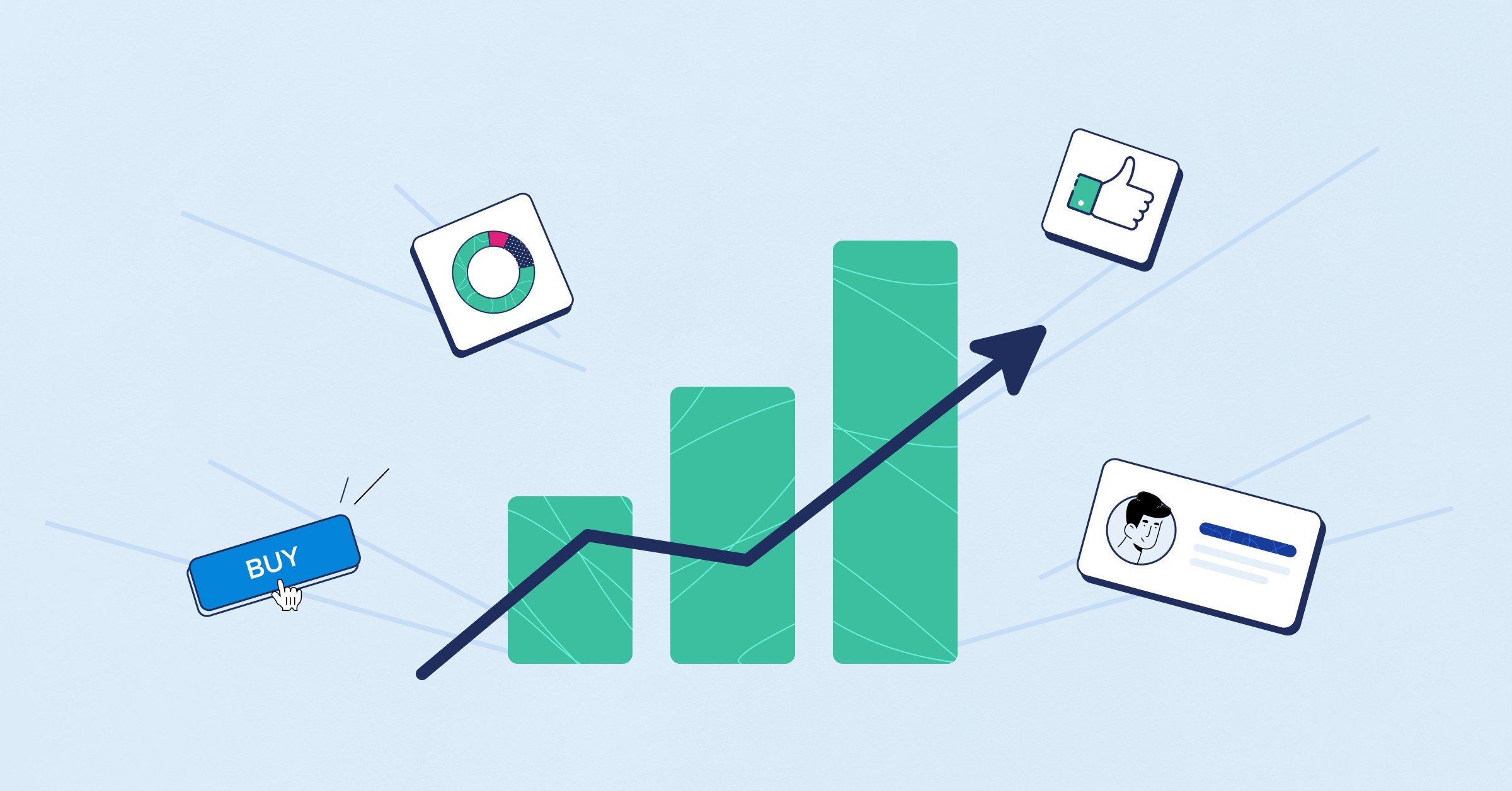As eCommerce is becoming increasingly widespread, tracking and measuring key performance indicators (eCommerce KPIs) to measure different business-wide areas is more important than ever. Monitoring KPIs across various departments helps businesses gain insight into how their operations are performing. And then they will improve overall success.
In this blog post, we will examine the best KPIs for eCommerce in each specific section within an eCommerce business and discuss top tracking metrics. With these insights from data professionals combined with your own knowledge of the industry you’re working in, you’ll be able to get a better understanding of what’s needed to maximize performance from all levels within your business.
Table of Contents
Understanding eCommerce KPIs
A key performance indicator (KPI) is a simple metric that businesses use to easily track their progress toward their primary goals. As a busy merchant, you don’t have time to delve into complex equations and data to understand how your performance is trending. KPIs should be straightforward to measure without requiring advanced expertise. It’s also important to keep the number of KPIs limited to avoid confusion about which metrics truly matter to your business, a few well-chosen indicators will suffice.
For instance, let’s consider a company that provides online coding courses. Their main objective might be to attract as many new users as possible to try their courses. To measure their progress, they could use KPIs such as the number of users signing up for a free trial or the monthly growth rate of trial users. Both of these KPIs simplify the overall goal into easily measurable data points.

Are you familiar with the well-known quote about insanity, which defines it as doing the same thing over and over again and expecting different results? In order to avoid this trap, eCommerce businesses establish and analyze their key performance indicators (KPIs) to address actions that consistently lead to poor performance. By using eCommerce KPI standards, organizations could compare their performance to that of their rivals and industries.
For marketers to understand in 2023, there is a mountain of data. The list of factors includes demographics, technology, browsers, keywords, target values, conversion rates, bounce rates, exit rates, acquisition, behavior, and time.
Google Analytics and Amazon Seller Central will provide your company with the information it needs. But without effective eCommerce KPIs, you won’t be able to turn that information into goals. By tracking KPIs over an extended period, organizations can observe their progress and even detect performance patterns. Additionally, presenting employees with clear numerical indicators is an excellent way to demonstrate how their efforts contribute to the overall success of the business.
The Role of KPIs in eCommerce Success
Key performance indicators (KPIs) hold significant importance, just like strategy and goal setting. Without KPIs, it becomes challenging to assess progress over time. Decision-making would rely solely on gut instinct, personal preferences, unfounded beliefs, or speculative hypotheses. KPIs provide valuable information about your business and customers, enabling you to make well-informed and strategic decisions.
- Tracking Sales Performance: eCommerce KPIs enable businesses to monitor their sales performance accurately. Metrics like revenue, conversion rate, average order value, and customer lifetime value provide valuable information about the effectiveness of marketing campaigns, pricing strategies, and overall sales growth.
- Analyzing Customer Behavior: KPIs help businesses understand customer behavior and preferences. Metrics such as website traffic, bounce rate, click-through rate, and time spent on the site provide insights into user engagement, indicating the effectiveness of website design, content, and user experience.
- Monitoring Inventory Management: Efficient inventory management is critical for eCommerce success. KPIs like stock turnover rate, sell-through rate, and inventory accuracy assist businesses in optimizing inventory levels, preventing stockouts or overstock situations, and minimizing carrying costs.
- Assessing Marketing Effectiveness: eCommerce KPIs allow businesses to evaluate the effectiveness of their marketing efforts. Metrics such as customer acquisition cost (CAC), return on ad spend (ROAS), conversion rate by marketing channel, and customer engagement metrics help identify the most profitable marketing channels and campaigns.
- Optimizing Customer Satisfaction and Retention: KPIs related to customer satisfaction, such as customer reviews, Net Promoter Score (NPS), and customer retention rate enable businesses to gauge customer loyalty and identify areas for improvement in customer service and post-purchase experiences.
- Monitoring Operational Efficiency: KPIs help track operational efficiency in eCommerce, including order fulfillment time, shipping accuracy, and customer support response time. Monitoring these metrics allows businesses to identify bottlenecks and enhance operational processes for improved customer satisfaction.

However, the true value of KPIs lies not in their existence but in the actionable insights derived from analyzing the data. By understanding these insights, you can develop more effective strategies to boost online sales and identify any existing issues within your business.
Moreover, the data associated with KPIs can be shared with your entire team, serving as an educational resource and fostering collaboration for crucial problem-solving endeavors. This allows employees to gain a deeper understanding of the business’s performance and encourages collective efforts toward overcoming challenges.
Most-used KPIs for Different Sections within eCommerce
Key performance indicators come in many different forms. They might be qualitative, quantitative, future-predictive, or historical-revealing. KPIs also have an impact on other company activities. The top KPIs for eCommerce often fit into one of the five categories listed below.
Sales KPIs
Sales KPIs are indicators that show you how your company is doing in terms of revenue and conversions. To help you make business decisions, you may use sales KPIs of a certain channel, time frame, team, employee, etc. Important eCommerce indicators and KPIs for sales include examples like:
- Sales: Online shops can keep track of overall sales by hour, day, week, month, quarter, or year. You need to capture accurate and comprehensive data for each sale, including transaction amount, customer details, product information, and sales channel. Additionally, checking your total sales, revenue, cost, and profit is necessary too. Regularly analyze this data to gain insights into sales trends, customer preferences, and performance against sales goals.

- Average order size: Also known as the average market basket, this figure indicates the normal amount spent by a consumer on a single order.
Average Order Size = Total Sales Revenue / Number of Orders
- Gross profit: It is a key performance indicator (KPI) that allows you to monitor your profitability by deducting the costs associated with production and distribution. It provides valuable insights into the amount of profit generated from your sales revenue.
Gross Profit = Revenue – Total Costs
- Average profit margin: it is a percentage that represents the profit margin of your business during a specific period. Ideally, as production or sales increase, you would want your average profit margin to also increase.
Average Profit Margin = (Gross Profit / Revenue) x 100
- Average order value: The Average Order Value (AOV), also referred to as the Average Market Basket, provides insights into the typical amount customers spend on a single order. By calculating the AOV, you can gain a clearer understanding of the revenue generated by each customer.
AOV = Total Revenue / Number of orders
- Transaction count: This represents the total number of transactions. For further insights, combine this KPI with the average order value or the total number of site visits.
- Conversion rate: The rate at which visitors to your eCommerce site convert or make a purchase, expressed as a percentage.
Conversion Rate = (Number of Conversions / Number of Visitors) x 100
- Shopping cart abandonment rate: The shopping cart abandonment rate is an essential eCommerce KPI that reveals the number of visitors who add products to their shopping carts but do not complete the purchase. By analyzing this metric, you can identify potential friction points in the checkout process and take measures to reduce cart abandonment, thereby improving overall conversion rates.
CAR = (1 – Total Completed Transactions / Total Shopping Carts) x 100
- Shopping Cart Conversion Rate (CCR): It is the percentage of website visitors who complete a purchase after adding items to their shopping cart. It is a crucial metric for measuring the effectiveness of the checkout process and overall conversion performance.
CCR = (Number of Completed Purchases / Number of Visitors with Shopping Carts) x 100
- Customer acquisition cost: reveals the amount you invest to acquire a new customer. This metric is determined by analyzing your marketing expenditure and dividing it by the number of acquired customers. A lower acquisition cost is desirable as it indicates efficient resource allocation and a higher return on investment.
CAC = Costs Spent on Acquiring Customers / Number of Customers Acquired
- Cost of goods sold (COGS): The cost of goods sold refers to the total expenses incurred to sell a product. This includes manufacturing costs, employee wages, overhead costs, and any other expenses directly associated with production and distribution. The lower the COGS, while meeting these requirements, the more favorable it is for your business.
COGS = Opening Inventory Costs (of the period) + Purchases Costs (of the period) – Closing Inventory Costs (of the period)
- Purchase frequency: the average number of purchases made by a customer within a specific timeframe. It is a key metric that provides insights into customer behavior and their engagement with a business.
Purchase Frequency = Total Number of Purchases / Total Number of Unique Customer
- Customer lifetime value (CLV): refers to the predicted total value that a customer will contribute to a business over the entire duration of their relationship as a customer. It is an essential metric for understanding the long-term revenue potential and profitability associated with acquiring and retaining customers.
CLV = Average Purchase Value × Purchase Frequency × Customer Lifespan
- Time Between Purchases: indicates the duration between a customer’s consecutive purchases. It provides insights into how long customers typically wait before making another purchase from your business.
Time between Purchases = 365 / Purchase Frequency
- Churn Rate: The churn rate is the percentage of customers or subscribers who discontinue their relationship with a business or service over a specific period of time. It is a crucial metric for measuring customer retention and the rate at which customers are lost.
Churn Rate = (Number of Customers Lost / Total Number of Customers at the Start of the Period) x 100
- Revenue per visitor (RPV): This metric provides an average of the amount spent by a person during a single visit to your website. If this KPI is low, it indicates that visitors are not making substantial purchases. In such cases, analyzing website analytics can help identify areas for improvement to drive more online sales.
RPV = Total Revenue / Number of Visits
- Repeat purchase rate (RPR): the percentage of customers who make multiple purchases or return to make subsequent purchases within a specific period. It is a key metric for measuring customer loyalty and the effectiveness of customer retention efforts.
RPR = (Number of Customers with Repeat Purchases / Total Number of Customers) x 100
- Product affinity: The product affinity KPI reveals which products are frequently purchased together by customers. This information is valuable for informing cross-promotion strategies.
- Product relationship: the connection or association between different products within a business’s portfolio. It involves analyzing the correlation, compatibility, or synergy between products, either in terms of functionality, customer preferences, or usage patterns.
- Inventory levels: provides insights into the quantity of stock available, how long the products have been in inventory, and the rate at which they are being sold. It helps businesses monitor stock levels, assess product turnover, and optimize inventory management.
- Inventory Turnover: It is a financial metric that measures how quickly a company sells its inventory within a specific period. It provides insights into how efficiently a business manages its inventory and the frequency at which it replenishes and sells its stock.
Inventory Turnover = Cost of Goods Sold (COGS) / Average Inventory
Marketing KPIs
KPIs for marketing let you know how you’re performing in terms of your advertising and marketing targets. These affect your sales KPIs as well as eCommerce KPIs in general.
You may utilize marketing KPIs to learn which things are selling and who, how, and why they are being purchased. This might aid in future product development, improved product descriptions, and more smart marketing.

You could use the following KPIs as examples in your marketing:
- Website traffic: Site traffic refers to the overall count of visits or the number of users accessing your online store. A higher site traffic indicates a greater number of users visiting your store and interacting with your website.
- Mobile site traffic: Mobile site traffic refers to the total number of visits or users accessing a website specifically through mobile devices, such as smartphones or tablets. It is a measure of the volume of visitors who access a website using mobile devices.
- Blog traffic: refers to the specific portion of website traffic that is directed toward your blog. By filtering your traffic view to specifically monitor blog traffic, you can gain valuable insights into the topics that your users find most interesting and engaging.
- Time on site: Time on site measures the duration visitors spend on your website. It provides insights into the level of engagement visitors have with your brand. Typically, a longer time on site suggests deeper interactions and interest in your content.
All four metrics above can be checked through Google Analytics. To check website traffic, mobile site traffic, blog traffic, and time on site, you can first sign in to your Google Analytics account. Then from the dropdown menu, choose the appropriate property that represents your website, mobile site, or blog. On the left-hand side, click on Reporting to access the reporting section. To check overall website traffic, go to Audience in the left-hand sidebar and click on Overview. Here, you can see metrics like Sessions, Users, Pageviews, and more.
To view mobile site traffic specifically, go to Audience in the left-hand sidebar, expand the Mobile section, and click on Overview. This report provides insights into mobile device usage, including metrics like Sessions, Users, and more.
To check blog traffic, if you have set up your blog as a separate property or segment in Google Analytics, you can navigate to that specific property or segment and explore the Audience Overview or Behavior reports to see blog-specific traffic metrics.
The last metric is time on site. To check the average time users spend on your website or specific pages, go to the Behavior section in the left-hand sidebar and click on Site Content or All Pages. You can see the average time on site as one of the columns in the report.
- Bounce rate: measures the percentage of visitors who leave a website after viewing only a single page without any further interaction. It indicates the level of engagement or lack thereof, as visitors bounce away without exploring additional pages or taking any desired actions.
Bounce Rate = (Total Number of Single-page Visits / Total Number of Entrances) x 100
- Pageviews per visit: Pageviews per visit represent the average number of pages that a user views on your website during each visit. It is an important metric that indicates user engagement and the extent to which visitors explore your website’s content.
Pageviews per Visit = Total Pageviews / Total Number of Visits
- Average session duration: Average session duration provides insights into the average amount of time that users spend on your website during a single session. It indicates the level of user engagement with your content. Generally, the longer the session duration, the more engaged the user is with your website.
Average Session Duration = Total Duration of all Sessions / Total Number of Sessions
- Traffic source: This metric provides insights into the origin of visitors and how they discovered your website. It reveals which channels are driving the most traffic, including organic search, paid advertisements, social media, and more.
- Day-part monitoring: Day-part monitoring refers to the practice of tracking and analyzing website or business performance metrics based on different time periods within a day. It involves segmenting and examining data to understand patterns, trends, and variations in performance during specific hours or time intervals.
- Newsletter subscribers: the number of users who have chosen to opt into your email marketing list. Having a larger subscriber base allows for a wider reach to potential consumers. However, it’s also important to consider additional data, such as the demographics of your newsletter subscribers, to ensure effective targeting of your desired audience.
- Texting subscribers: SMS-based marketing, a newer digital marketing approach than email, allows eCommerce brands to connect with consumers through text messages. Texting subscribers refers to the count of customers who has opted in to receive marketing communications via SMS.
- Subscriber growth rate: indicates the pace at which your subscriber list is expanding. By combining this key performance indicator (KPI) with the total number of subscribers, you can gain valuable insights into the progress and potential of this communication channel.
Subscriber Growth Rate = [(Ending Subscribers – Starting Subscribers) / Starting Subscribers] x 100
- Email open rate: Email open rate is a metric that measures the percentage of recipients who open an email that has been sent to them. It indicates the effectiveness of your email marketing campaigns in capturing the attention and engagement of your audience.
Email Open Rate = (Number of Emails Opened / Number of Emails Delivered) x 100
- Email click-through rate (CTR): refers to the percentage of subscribers who clicked on a link or call-to-action (CTA) within an email after opening it. Unlike the open rate, the CTR provides insights into subscriber engagement and their willingness to take further action.
Email Click-Through Rate (CTR) = (Number of Email Clicks / Number of Delivered Emails) x 100
- Email conversion rate: It refers to the percentage of recipients who take the desired action or complete a specific goal after engaging with an email campaign. It measures the effectiveness of your email marketing efforts in driving conversions and achieving your desired outcomes.
Email Conversion Rate = (Number of Conversions / Number of Delivered Emails) x 100
- Unsubscribes: Examining both the total number and the rate of unsubscriptions allows you to monitor the attrition of subscribers from your email list.
- Chat sessions initiated: The number of chat sessions initiated using live chat functionality on your eCommerce store indicates the count of users who actively engaged with the tool to interact with a virtual assistant or chatbot.
- Social media followers: The number of followers or fans you have on social media platforms like Facebook, Instagram, Twitter, Pinterest, or Snapchat is a valuable KPI that can help assess customer loyalty and brand awareness. These social media networks often provide tools that eCommerce businesses can utilize to gain insights into their social followers.
- Social media engagement: Social media engagement refers to the level of interaction and involvement that your followers and fans demonstrate with your brand on social media platforms. To check engagement data on Facebook and LinkedIn, you can access some specific sections in the admin panel of each platform. You’ll find different sections such as Overview, Likes, Reach, and more. Click on the section relevant to the type of engagement data you want to check.
- Clicks: refers to the overall count of user interactions with a specific link. This KPI can be measured across various channels such as websites, social media platforms, email campaigns, display ads, and pay-per-click (PPC) campaigns.
- Customer retention rate: The customer return rate is a vital eCommerce metric that represents the percentage of customers from a specific time period who revisit your website and make a purchase. This metric holds significant importance as it helps determine whether customers are returning to your business or not.
Customer Retention Rate = [(Customers at the End of a Period – New Customers during That Period) / Total Customers at the Start of That Period] x 100
- Return on ad spend (ROAS): measures the effectiveness and profitability of advertising campaigns by evaluating the revenue generated in relation to the amount spent on advertising.
ROAS = (Revenue from Ad Campaign / Cost of Ad Campaign) x 100
- Blended ROAS: This is a metric that combines the total ad spend across all advertising channels to provide a comprehensive perspective on the overall revenue generation efficiency of your ad campaigns.
Blended ROAS = (Total Revenue from All Ad Campaigns / Total Cost of All Ad Campaigns) x 100
- Cost per click (CPC): also known as pay-per-click, is a key performance indicator (KPI) that reveals the cost incurred for each click on your paid advertisements displayed on platforms like Google, Facebook, or other channels.
CPC = Total Cost of Advertising / Total Number of Clicks
- Average click-through rate (CTR): indicates the percentage of users on a page or asset who actively click on a link presented to them.
CTR = (Total Clicks / Total Impressions) x 100
- Search ranking: provides insights into the search engine optimization (SEO) and paid search performance of your website. It indicates the position of your website on search engine results pages (SERPs) for specific keywords or queries. Many online retailers aim to achieve the top position for their targeted keywords.
- Pay-per-click (PPC) traffic volume: If your marketing efforts heavily rely on pay-per-click (PPC) campaigns, monitoring your PPC traffic volume is a crucial key performance indicator (KPI) to track. It provides valuable insights into the amount of traffic generated by these campaigns and their impact on your website.
- Core Web Vitals: Core Web Vitals are metrics introduced by Google to assess the user-friendliness and page speed of a website. They primarily focus on measuring page load speed and responsiveness to user interactions. Two important Core Web Vitals metrics are LCP (Largest Contentful Paint) and CLS (Cumulative Layout Shift).
- LCP measures the time it takes for the largest content element on a webpage to become visible to the user
- CLS measures the visual stability of a webpage by quantifying the number of unexpected layout shifts that occur during the loading process. By addressing any issues or deficiencies identified by these metrics, website owners can improve their chances of receiving favorable recognition from Google.
- Backlinks: Backlinks can be likened to voting for your website from other websites. These votes serve as indicators to search engines like Google that your content is valuable and trustworthy, potentially leading to higher rankings in search results. Referring domains are external websites that contain backlinks pointing to your website. These domains play a significant role in search engine optimization (SEO) and can impact your website’s visibility and authority.
- Number and quality of product reviews: Product reviews offer numerous benefits for your eCommerce business. They serve as social proof, contribute to search engine optimization (SEO), and provide valuable feedback. Tracking the quantity and content of product reviews is essential as these are key performance indicators (KPIs) that help measure the success of your business.
- Display advertising CTR: The click-through rate (CTR) for your display ads indicates the percentage of viewers who have clicked on the ads. Monitoring this key performance indicator (KPI) provides valuable insights into the performance of your ad copy, imagery, and offers.
CTR = (Number of Clicks / Number of Impressions) x 100
- Affiliate performance rates: If you participate in affiliate marketing, tracking this key performance indicator (KPI) will provide valuable insights into the most successful channels for your affiliate partnerships.
- Share of voice (SOV): refers to the portion of the market that your brand dominates in comparison to your competitors. It serves as a valuable measure of the level of conversation and attention surrounding your brand.
SOV = (Your Brand’s Total Mentions / Total Industry Mentions) x 100
- Conversion by device type: refers to the total number of conversions that occur on a specific device type, such as mobile, tablet, or desktop.
- Traffic to lead ratio: measures the conversion efficiency of your website or marketing campaigns by comparing the number of website visitors to the number of generated leads.
Traffic to Lead Ratio = (Number of Leads / Number of Website Visitors) x 100
- Lead to customer ratio: measures the conversion rate of leads into paying customers. It helps evaluate the effectiveness of your lead nurturing and sales processes in converting leads into actual revenue-generating customers.
Lead to Customer Ratio = (Number of Customers / Number of Leads) x 100
- Marketing revenue attribution: This is a vital eCommerce KPI that enables you to monitor the amount of revenue generated by your marketing efforts. It allows you to categorize and analyze the revenue attributed to various marketing skills and strategies employed by your business, such as content marketing or influencer marketing.
Marketing Revenue Attribution = Revenue x Attribution Weight
Customer Service KPIs
KPIs for customer service let you know how well you’re fulfilling expectations and how successful your customer service is. What should the KPIs be for our contact center, email support staff, social media support team, etc.? is a question you could have. By measuring and monitoring these KPIs, you can make sure that you’re giving your customers a good experience.
- Customer satisfaction (CSAT) score: The Customer Satisfaction (CSAT) KPI is commonly assessed through a widely used survey question: How satisfied were you with your experience? Customers provide their responses on a numerical scale to indicate their level of satisfaction. Tracking customer satisfaction is crucial as it can significantly influence various aspects of your business operations.
CSAT Score = (Number of Satisfied Customers / Total Number of Respondents) x 100
- Net promoter score (NPS): The Net Promoter Score (NPS) KPI offers valuable insights into customer relationships and loyalty by assessing the likelihood of customers recommending your brand to others in their network.
NPS = Percentage of Promoters – Percentage of Detractors
- Hit rate: measures the success of converting customer inquiries into actual product sales. It is calculated by dividing the total sales of a product by the number of customers who have shown interest or sought information about that specific product.
Hit Rate = (Number of Successful Sales / Number of Customer Inquiries) x 100
- Customer service email count: This is the total number of emails received by your customer service team from customers seeking assistance or support.
- Customer service phone call count: represents the frequency at which customers reach out to your customer support team through phone calls instead of emails.
- Customer service chat count: refers to the total number of chat interactions or conversations initiated by customers on your eCommerce site’s live chat feature.

- First response time: represents the duration it takes for your team to initially reach out to a customer regarding their inquiry. Minimizing this time is crucial to ensuring that customers feel promptly attended to and their needs are addressed in a timely manner.
- Average resolution time: refers to the duration it takes for a customer support issue to be fully resolved, starting from the moment the customer initially contacts your support team regarding the problem. It measures the average time it takes to address and resolve customer inquiries or issues.
Average Resolution Time = Total Time Spent on Resolving Inquiries / Number of Resolved Inquiries
- Active issues: refer to the number of unresolved or ongoing customer inquiries or problems that are currently being addressed by your customer support team.
- Backlogs: the accumulation of unresolved tasks, requests, or issues that have not been addressed within the expected timeframe. It represents the workload that has accumulated and needs to be addressed by your team.
- Return rate: measures the percentage of products or orders that are returned by customers. It indicates the frequency at which customers are returning items they have purchased.
Return Rate = (Number of Returns / Number of Orders) x 100
- Service escalation rate: This metric measures the percentage of customer service interactions or inquiries that require escalation to a higher level of support or management. It indicates the frequency at which customer issues or concerns need to be escalated beyond the initial support representative or team.
Service Escalation Rate = (Number of Escalated Cases / Total Number of Cases) x 100
Manufacturing KPIs
Manufacturing KPIs are, naturally, linked to your supply chain and production methods. These might provide you with information on where there are efficiencies and inefficiencies. Also, they will assist you in comprehending productivity and costs.
- Cycle time: The manufacturing KPI for cycle time shows you how long it takes to make one product from beginning to end. You may gain insight into manufacturing efficiency by tracking this KPI.
- Overall Equipment Effectiveness (OEE): This metric offers eCommerce businesses valuable insights into the performance of their manufacturing equipment. It helps assess how efficiently and effectively the equipment is operating.
- Overall labor effectiveness (OLE): It provides businesses with insights into the productivity and efficiency of their workforce. It measures how effectively labor resources are utilized to accomplish tasks and contribute to overall business goals.
- Yield: Yield is a simple yet important manufacturing KPI that represents the total number of products or units manufactured. It provides an indication of the quantity of outputs generated through the production process.
- First time yield (FTY) and first time through (FTT): First Time Yield (FTY), also known as First Pass Yield (FPY), is a quality-based KPI that provides insights into the efficiency and effectiveness of production processes. It measures the percentage of units or products that successfully pass through the production process without requiring rework or repair.
FTY = (Number of Successfully Manufactured Units / Total Number of Units Started) x 100
- Number of non-compliance events or incidents: In the manufacturing industry, businesses are subject to various regulations, licenses, and policies that govern aspects such as safety, working conditions, and product quality. It is important for businesses to minimize the number of non-compliance incidents to ensure full adherence to these mandated guidelines.
Project Management KPIs
KPIs for project management provide you with information about how well your teams are carrying out certain activities. This is crucial when managing an eCommerce business.
Your eCommerce company’s projects and initiatives must be managed using various procedures and workflows since each has a different set of objectives. Project management KPIs let you know how well each team is pursuing its own objectives. You will also get aware of how effectively its internal systems are facilitating that pursuit.
- Total hours worked: This number reveals how much time a team invested in a project. To more accurately anticipate and resource future projects, project managers should also evaluate the discrepancy between expected and actual labor hours.
- Budget: The budget details the amount of money committed to the particular project. A reasonable budget is important for project managers and eCommerce business owners; if you consistently go over budget, your project planning has to be adjusted.
- ROI – Return on investment: The ROI KPI for project management reveals how much money your efforts brought in for your company. The better, the higher this number. The ROI takes into account all of your project-related costs and income.
ROI = (Net Profit / Cost of Investment) x 100
- Cost variance: Comparing the actual cost with the predicted or budgeted cost is essential for evaluating project or activity expenses. By analyzing the total cost variance, you can gain insights into areas where cost control measures are necessary or where additional investments may be beneficial.
Cost Variance = Actual Cost – Budgeted Cost
- Cost performance index (CPI): This metric evaluates the efficiency of resource investment. Similar to Return on Investment (ROI), the CPI provides insights into the value derived from the resources allocated to a project. It is calculated by dividing the earned value by the actual costs.
CPI = Earned Value / Actual Costs
Examples of Top eCommerce KPIs to Track
Conversion Rates
Conversion rates show you what proportion of your target market is taking the intended action. This may have something to do with click-through rates on social media, click-through rates on Google search engine results in pages, or conversion rates on your website.

On your website, you may monitor a variety of conversion rate KPIs, such as how many visitors sign up for your newsletter, establish an account, join your loyalty program, or make a purchase.
They are a wonderful indicator of overall performance since if your conversion rates are rising, your other eCommerce metrics will often perform well as well. Similarly to this, if you have a proper set of conversion rate KPIs, you can pinpoint the problems if you notice a downward trend in your sales and revenue.
Average Order Value (AOV)
What percentage of sales are made on your website? The average order value (AOV) reveals the average amount each consumer pays on each transaction.

This is one of the more straightforward eCommerce KPIs, but it’s crucial to monitor. It may reveal how much you spend on gaining new customers and can aid in your comprehension of consumer buying habits.
One of the best (and least expensive) strategies to boost sales and profit is to enhance AOV. In a perfect world, your acquisition costs would be far lower than what customers would pay for their purchases.
Customer Acquisition Cost (CAC)
The cost of acquiring a new customer is indicated by the customer acquisition costs.
You should take into account your operating expenses as well as the expenditures of promoting and selling new customers. This KPI is significant for shops that offer low-margin goods since it may also be used to determine pricing points.
Customer Acquisition Costs should decrease as a company grows in exposure and awareness, making it a useful KPI to set goals for. To make judgments, you need more information than just the cost of recruiting new clients. So, to obtain a better picture of your performance, compare your CAC to other measures like your AVO.
Customer Lifetime Value (CLTV)
One of the best eCommerce KPIs to monitor is this, especially if your goal is to boost client retention. If you run a business that specializes in selling high-end goods, it can also be helpful.

Customer Lifetime Value reveals how much money a buyer will typically spend with you over the course of their relationship.
This KPI provides excellent insight into the entire success of your shop because it takes into account eCommerce data like average order value, conversion rate, and customer retention.
The lower your repeat business will be, the closer your CLTV is to your AOV. In this situation, it is wise to implement certain modifications to enhance the client experience and encourage repeat business.
Product Performance KPIs
You can better analyze the success of each product by breaking down your eCommerce KPIs at the product level. It’s a really useful exercise for a manager of eCommerce marketing. Additional KPIs to think about can include category-specific KPIs.
It is essential for you to take into account your product performance on the third-party retailer website if you sell your brand through a third-party retailer (such as Amazon, Tesco, etc.).
You should look at which of your items are selling the best on websites run by independent retailers. What can you do to boost sales numbers? Determine the items being purchased as well as the locations where they are being made.
You can control your brand on retailer websites if you have the capacity to gauge the effectiveness of each product sold through independent merchants. Look closely and get details on product-specific conversions for each brand the merchant sells.
Net Profit
Net profit is sometimes neglected when it comes to eCommerce performance measures, yet it is a crucial sign of how well your shop is doing overall.
For new businesses, turning a profit is a significant milestone that will determine how much you can spend on marketing, customer service, and other growth-oriented initiatives.
The same goes for large firms; sustaining a high net profit level is a valuable eCommerce KPI to monitor. You can be sure that members of the marketing and sales department are thinking about it even if it may not have the same stakes in terms of the continued success of the company.
Cost per Acquisition (CPA)
This resembles the CAC KPI mentioned above. But with Cost per Acquisition, you don’t only assess the cost of recruiting paying customers; you also measure the cost of getting new leads and non-paying users.
Therefore, this is a perfect KPI to track your success if your company plan is to increase brand recognition through free samples, mailing marketing, or gated content. It’s perfect for eCommerce startups and shops that sell expensive goods. They could even wish to go further and track this KPI on certain platforms, like Facebook or Instagram.
Shopping Cart Abandonment Rate (CAR)
Given how many customers abandon their shopping carts before checking out, the shopping cart abandonment rate (CAR) is a vital KPI for eCommerce websites. Whether revenue, customer service, or branding are your top priorities, a high percentage of shopping cart abandonment can affect your organization.

This eCommerce metric is widely used to assess how user-friendly and dependable your checkout process is. If your site’s shopping cart abandonment rate is high, it might be time to redesign it.
If many customers add items to their shopping carts but never complete the checkout process, they might not like your shipping costs, payment alternatives, or checkout procedure. To get customers to convert, you might need to give more payment alternatives or use a reputable payment service provider like PayPal or Stripe.
Cost of Goods Sold (COGS)
It is an evaluation of the direct expenses connected with manufacturing the products you sell and is occasionally referred to as the cost of sales.
Online merchants may better understand their manufacturing and production costs by using the retail performance indicator COGS. It doesn’t include marketing expenses or overhead costs. It’s important to keep in mind that COGS will change based on the accounting principles applied to the calculations.
Return on Ad Spend (ROAS)
Digital marketers must pay close attention to the critical eCommerce indicator known as return on ad spend (ROAS).
Although it is a KPI comparable to the one for cost per acquisition, there is a significant difference between the above. Cost per acquisition relates to the overall cost incurred to acquire a consumer, whereas ROAS is particularly tied to the income that advertising creates. These eCommerce KPIs are connected since ROAS directly influences CPA.
Utilizing KPIs for Continuous Improvement
Utilizing KPIs (Key Performance Indicators) for continuous improvement involves setting strategic goals, identifying the relevant KPIs to measure performance, analyzing these metrics regularly, and using this information to refine processes and operations. Here’s how you can do it.
Identify Relevant KPIs
Identifying appropriate eCommerce KPIs for your online enterprise is crucial. To achieve this, pertinent questions must be considered, including:
- What industry is your business in?
- Are you operating a newly-founded startup or a well-established venture?
- What are your current business objectives?
By addressing these questions, you can unveil the most critical eCommerce KPIs suitable for your online venture and define the precise goals you aim to achieve.
Expert Tip: Pinpoint one Primary KPI (PKPI) and select between four to eight secondary KPIs that can bolster your PKPI. Common examples of PKPIs include:
- Customer Lifetime Value (CLV)
- Cost Per Acquisition (CPA)
- Return on Ad Spend (ROAS)
- Value-per-Visit
Implement Accurate Measurement of Your eCommerce KPIs
Ensuring accurate measurement of your eCommerce KPIs is critical to the success of your online business. It not only provides reliable insights into your business performance but also helps guide data-driven decision-making.
Always remember: accurate data collection is key. Invest in reliable analytics tools that can effectively track the data associated with your chosen KPIs. Tools like Google Analytics, Adobe Analytics, and Shopify Analytics can provide comprehensive insights into your eCommerce operations.
You need to ensure each KPI is clearly defined with specific parameters to avoid ambiguity. For instance, if your KPI is Sales Conversion Rate, make sure everyone in your team understands what counts as a conversion.
Additionally, your team members all need to be adequately trained in using your analytics tools and understand how to interpret the data. The more familiar they are with the process, the less room there is for error.
Set up Benchmarks to Track Success
Business benchmarks or milestones are essential for business expansion, offering key insights into effective strategies and those that need refinement. They also enable you to assess the growth rate of your eCommerce KPIs.
Here are six straightforward steps to benchmark your primary eCommerce KPIs:
- Define your long-term business objectives.
- Evaluate the present performance of your website.
- Identify the aspects requiring attention for measurement.
- Determine the appropriate KPIs to monitor for success.
- Establish a benchmarking schedule or plan.
- Implement, evaluate, adjust, and repeat!
Through this process, you can strategically use your benchmarks to inform your business decisions and drive growth in your eCommerce venture.
In Conclusion,
Different sections of an eCommerce store have different optimization goals. In order to get a holistic view of your store’s performance, it’s important to track all of these KPIs and use them together to improve your conversions. Do you track all of these eCommerce KPIs in your eCommerce business? What other metrics do you find useful? Share your thoughts with or if you have any questions and need support for this issue from us, don’t hesitate to let us know!











